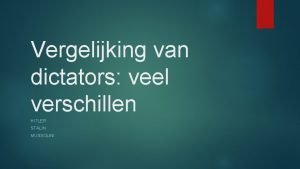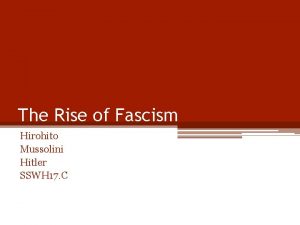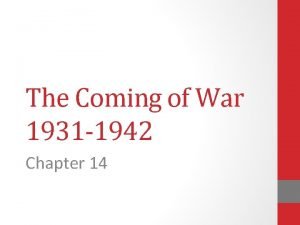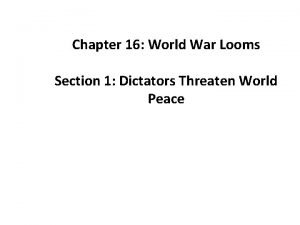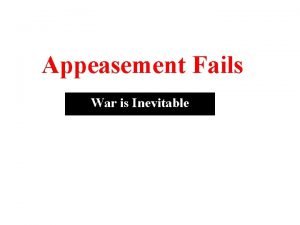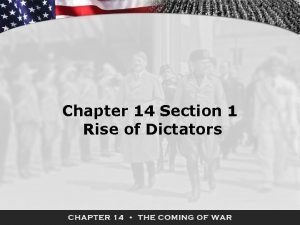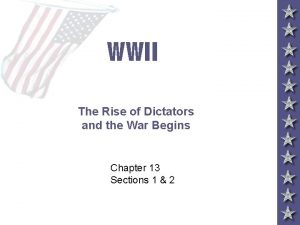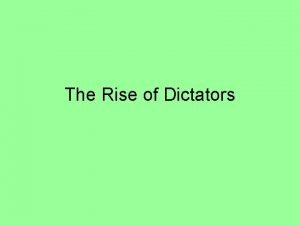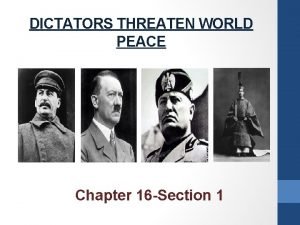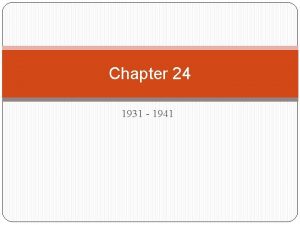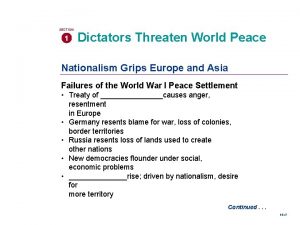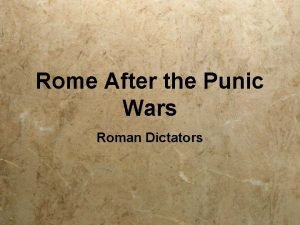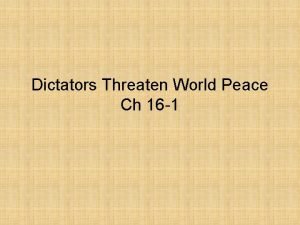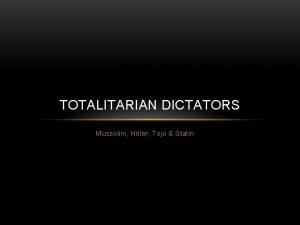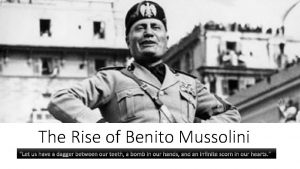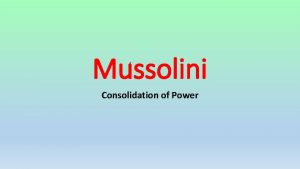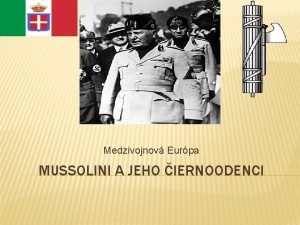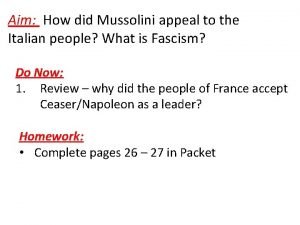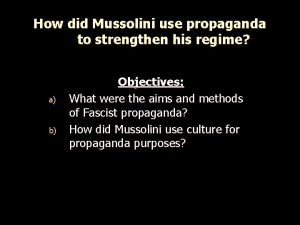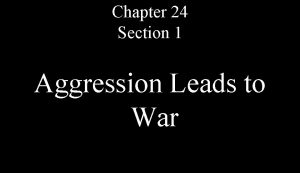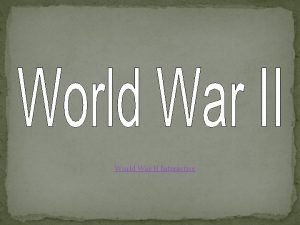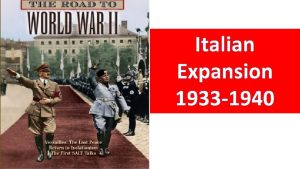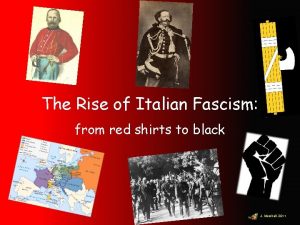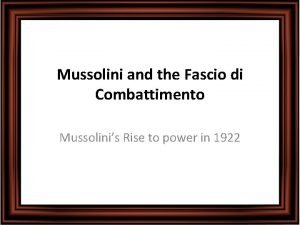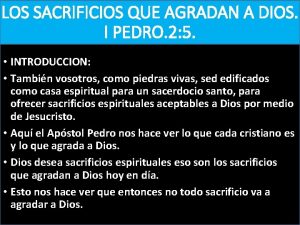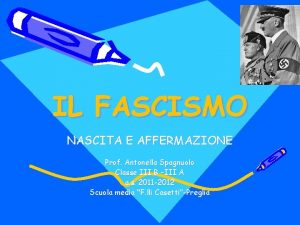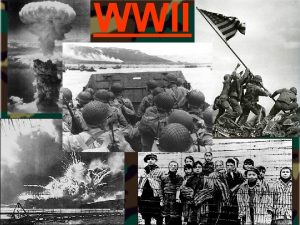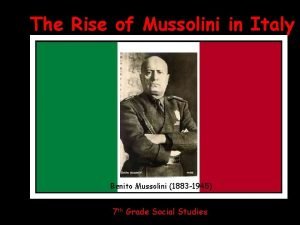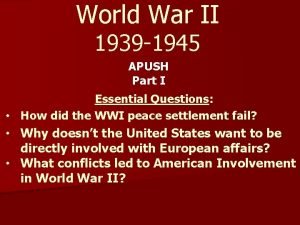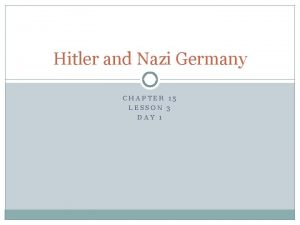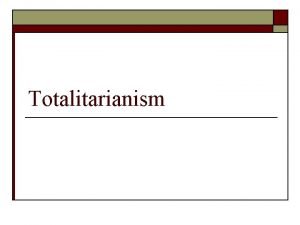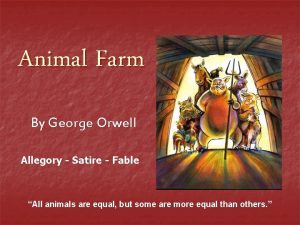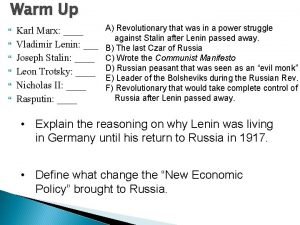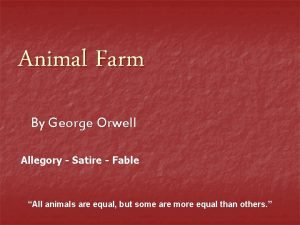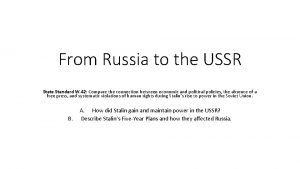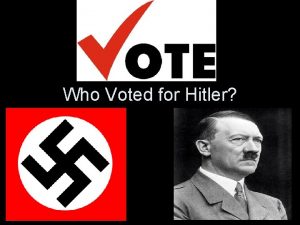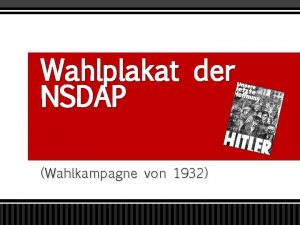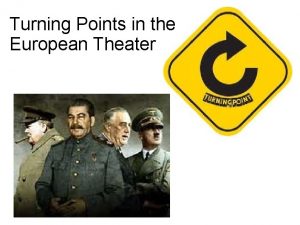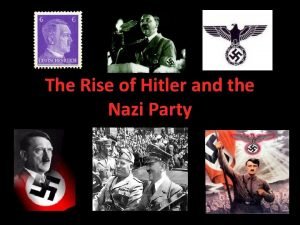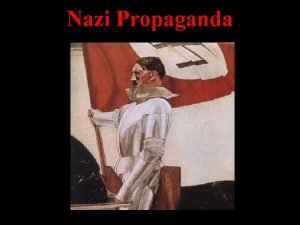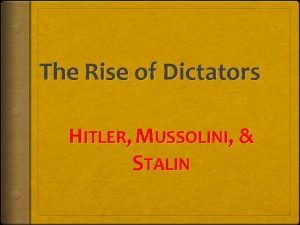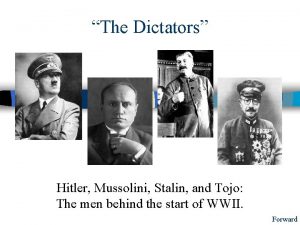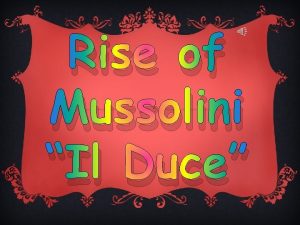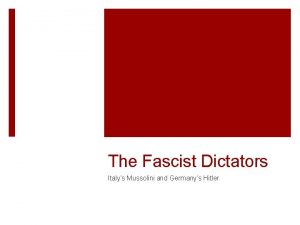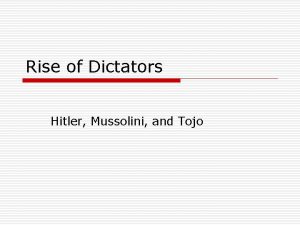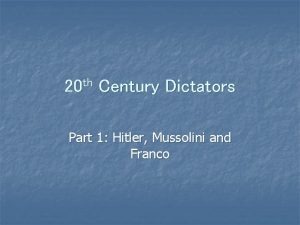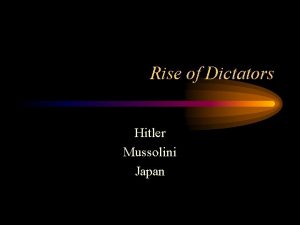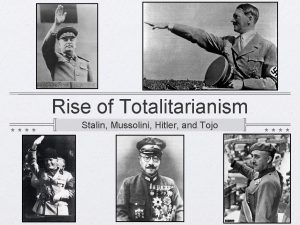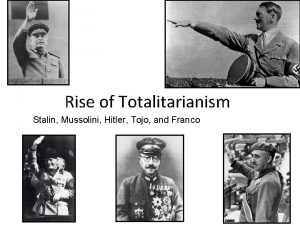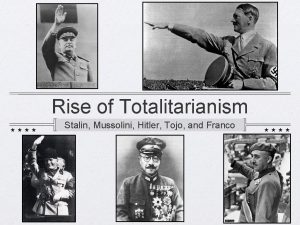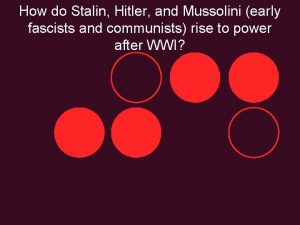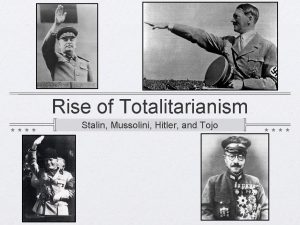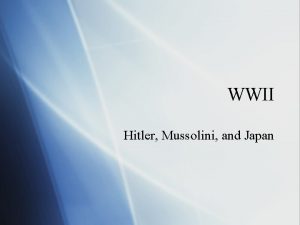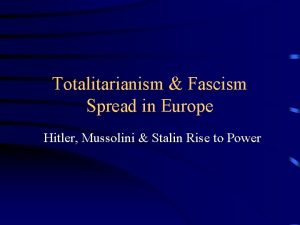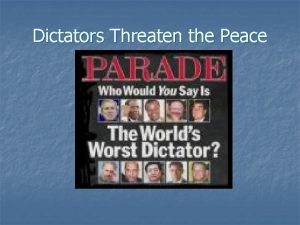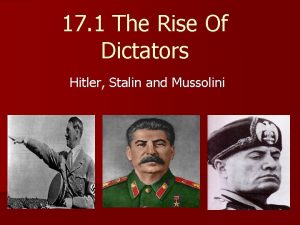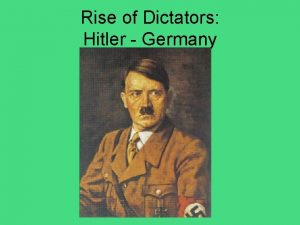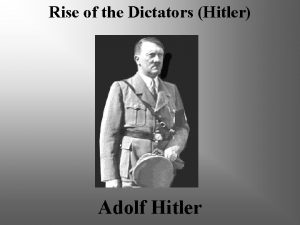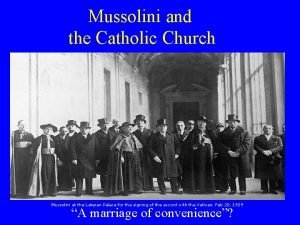European Dictators Mussolini Stalin and Hitler Stalin and










































![The Great Depression [1929 -1941] London in 1930 Paris in 1930 The Great Depression [1929 -1941] London in 1930 Paris in 1930](https://slidetodoc.com/presentation_image_h2/a6679296fe250eef1e9737f998535e2b/image-43.jpg)

![The Great Depression [1929 -1941] The Great Depression [1929 -1941]](https://slidetodoc.com/presentation_image_h2/a6679296fe250eef1e9737f998535e2b/image-45.jpg)



- Slides: 48

European Dictators Mussolini, Stalin, and Hitler

Stalin and the Soviet Union

My "wonderful Georgian" • Stalin was appointed to General Secretary (controlled the organization and direction of the Bolsheviks) • Lenin was paralyzed after a surgery to remove a bullet and Stalin became his spokesman • Stalin began to disagree with Lenin

Lenin on Stalin • Lenin said of Stalin: "Comrade Stalin, having become General Secretary, has concentrated enormous power in his hands: and I am not sure that he always knows how to use that power with sufficient caution. I therefore propose to our comrades to consider a means of removing Stalin from this post and appointing someone else who differs from Stalin in one weighty respect: being more tolerant, more loyal, more polite, more considerate of his comrades. " "Stalin is too rude, and this fault. . . becomes unbearable in the office of General Secretary. Therefore, I propose to the comrades to find a way to remove Stalin from that position and appoint to it another man. . . more patient, more loyal, more polite and more attentive to comrades, less capricious, etc. This circumstance may seem an insignificant trifle, but I think that from the point of view of preventing a split and from the point of view of the relations between Stalin and Trotsky. . . it is not a trifle, or it is such a trifle as may acquire a decisive significance. " Three days after writing this testament Lenin had a third stroke

After Lenin • Lenin did not choose a successor to his position, so when he died there was a struggle for power between Trotsky and Lenin • Stalin eventually won the battle for power and took over as leader of the Soviet Union • Unlike Lenin, Stalin did not follow Karl Marx’s communist theory to lead • Instead of gradually reducing government power, Stalin turned the Soviet Union into a totalitarian state • Video

The Five-Year Plans (19281938) • Stalin wanted to improve the economy and implemented 3 sets of five-year production goals for all factories and mines • The plans relied on exports to increase government profit at the expense of the peasantry. • Strikers were shot, slow workers were imprisoned

Collectivization • Stalin took away all lands from peasant farmers created large, mechanized farms to increase production • When the peasants protested, he had them killed or sent to Siberia; millions of resisters in the Ukraine starved to death when Stalin refused to send them food during a famine • No consumables were produced

The Purges • Reasons: – The country needed to be unified to be strong – Worried that Germany would invade again • Needed to increase the capacity of the Soviet industry – Gulag- labor prison • 1 st purge went against anyone who was anticollectivism • Great Purge (1934 -39) – the arrest and murder of all political opponents

Italy and Mussolini • After WWI Italy’s leadership was unstable and indecisive • Mussolini, once a strong promoter of socialism, helped create a new political group called the National Fascist Party • Wanted to build an Italian empire that would be more glorious than the Roman Empire • He believed fascism was necessary to make Italy strong • Fascism places the good of the nation above all else, including individual rights; an allpowerful dictator makes all major decisions

Mussolini in Power • Mussolini’s fascist party got a lot of support, but he wanted total control • He organized a march on Rome to force the king of Italy to give him power, and the king put Mussolini in charge • Mussolini use propaganda to promote his ideas and convince the people that Italy was the greatest country on Earth • Introduced new holidays and festivals to remind people if their Roman heritage

Ethiopia • Mussolini wanted to display Italy’s military strength and expand his empire • He chose to invade Ethiopia for two reasons • Ethiopia was an easy target • It was the territory that had defeated the Italian armies during the Age of Imperialism • The League of Nations refused to stop Mussolini from conquering Ethiopia because they were afraid it would lead to another world war

Section 4 The Interwar Years Mussolini’s Italy After World War I, new ideas about government power promoted by Benito Mussolini led to drastic change in the Italian government. Fascist Ideology Mussolini in Power • Mussolini wanted to build a great, glorious Italian empire • Fascists significant force in Italian politics, 1922 • Founded National Fascist Party, 1919 • Mussolini wanted more, wanted to rule Italy – from Latin fasces, Roman symbol for unity, strength • Called March on Rome – Fascism, authoritarian form of government • Show of force convinced Italy’s king to put Mussolini at head of government – Good of nation above all else • Mussolini moved to establish dictatorship

Hitler and Nazi Germany

How did Hitler Turn the Chancellorship into a Dictatorship?

Hyper. Inflation: The depression after the Wall Street Crash made many more people vote for the Nazis because they promised to rebuild Germany In 1933 advisors convinced Hindenburg that Hitler should become Chancellor January 1933

February 1933

q The Reichstag, the building where the German government met, burned down February 1933 q A communist was found inside the building. He admitted responsibility after having “a little chat” with Nazi officials q Chancellor Hitler was able to convince people that the Communists were trying to take power by terrorism q He was able to have the Communists banned from the Reichstag

With the Communists banned from the Reichstag Hitler was able to pass: March 1933 HITLER CAN RULE ALONE FOR FOUR YEARS WITHOUT HAVINGTO CONSULT THE REICHSTAG

The Enabling Act allowed Hitler to make his own laws, so he banned all other political parties!


June 1934 • Now I have gotten rid of opposition political groups, I can now deal with opposition in my party. • The head of the S. A. is very unpopular with the German army leaders who have the power to overthrow me • I’ve been worried about him for a while, so this is a good excuse to get rid of him

The Night of the Long Knives • Hitler had to get rid of the head of the S. A. He was too much of a threat • On the night of June 30 1934, Hitler’s S. S. killed over 1000 SA members including their leader • The army was pleased and Hitler gained their support

A final note August 1934 PRESIDENT HINDENBURG’S death ALLOWED HITER TO COMBINE THE ROLE OF CHANCELLOR AND PRESIDENT. HE CALLED HIMSELF ‘DER FUHRER’.

Every soldier swore a personal oath of loyalty to ADOLF HITLER.


HITLER BECAME CHANCELLOR OATH OF LOYALTY TO HITLER THE REICHSTAG FIRE THE ENABLING ACT DEATH OF PRESIDENT HINDENBURG THE NIGHT OF THE LONG KNIVES

Putting Germany Back to Work

Germany 1933 Ø By January 1933, unemployment had reached 6, 000. Ø No one would loan Germany money to run the country Ø The Weimar Government couldn’t do anything to help the unemployed Ø Hitler was elected on a promise to give the German people ‘Bread & Jobs’

Impact of Hitler’s Policies on Unemployment

How Did Hitler Put Germany Back to Work?

RAD – The National Labor Service Ø Gave men jobs in public work schemes Ø Men in RAD had to wear a uniform & live in camps Ø They were given free meals and pocket money Ø They built drainage ditches, schools, a new network of motorways, and planted new forests

To improve the living conditions of the German people Kick start the Cycle of Prosperity What was the goal of Hitler’s Public Works Program? To build impressive buildings so that the German To improve the public transport network for industrial & military

Autarky – National Self Sufficiency Ø Hitler wanted to make Germany a strong independent country that was sufficient in food and materials Ø Germany had lost WWI because it had run out of food and war materials Ø German scientists developed all sorts of artificial substitutes such as gas from coal and coffee from acorns Ø These new substitutes were made in Germany and gave the unemployed jobs in new industries Ø Hitler also encouraged the growth of the car industry

The Car Industry Ø Designed by Porsche and nicked named “The Peoples Car, ” known today as the ……?

Created Jobs in other industries because of the need for standardized parts. Produced low cost cars which helped to keep the German people happy Car Industry Car Production could easily be switched to the production of military vehicles Stee l Glass Rubb er Leath er Cycle of

What Other Things Did Hitler Do to Reduce Unemployment? Ø By 1934 all Jews were fired from civil service jobs which were then given to German workers. Ø Unemployed Jews were not registered. Ø Women lost their jobs which were given to men. Ø People who refused jobs offered by the labor service were arrested and put into concentration camps.


League of Nations Members

The Maginot Line. A vast fortification that spread along the French/German border Three schools of thought developed to defend France in the future: 1) That France should adopt a policy of offence as opposed to defense. 2) France should base its military in a line of small heavily defended areas from which a counter-attack could be launched. 3) France should build a long line of fortifications along the whole French/German border which would be both long and deep into France. Marshall Petain favoured this idea.

Locarno Pact: 1925 - series of agreements that guarenteed peace between Germany, Britain, and France Austin Chamberlain (Br. ) Aristide Briand (Fr. ) Gustave Stresemann (Ger. ) § Guaranteed the common boundaries of Belgium, France, and Germany as specified in the Treaty of Versailles of 1919. § Germany signed treaties with Poland Czechoslovakia, agreeing to change the eastern borders of Germany by arbitration only.

Kellogg-Briand Pact: 1928 § 15 nations committed to outlawing aggression and war for settling disputes. § Problem no way of enforcement.

Video
![The Great Depression 1929 1941 London in 1930 Paris in 1930 The Great Depression [1929 -1941] London in 1930 Paris in 1930](https://slidetodoc.com/presentation_image_h2/a6679296fe250eef1e9737f998535e2b/image-43.jpg)
The Great Depression [1929 -1941] London in 1930 Paris in 1930

German Unemployment: 1929 -1938
![The Great Depression 1929 1941 The Great Depression [1929 -1941]](https://slidetodoc.com/presentation_image_h2/a6679296fe250eef1e9737f998535e2b/image-45.jpg)
The Great Depression [1929 -1941]

Decrease in World Trade: 19291932

German Election Results in 1933

The “New Napoleons? ”
 Verschil communisme en fascisme
Verschil communisme en fascisme Hirohito mussolini hitler
Hirohito mussolini hitler How did stalin come to power
How did stalin come to power Chapter 16 building vocabulary world war looms
Chapter 16 building vocabulary world war looms Hitler and stalin
Hitler and stalin Hitler stalin mao
Hitler stalin mao Chapter 14 section 1 dictators and war
Chapter 14 section 1 dictators and war Rise of dictators graphic organizer
Rise of dictators graphic organizer Dictators threaten world peace
Dictators threaten world peace Chapter 16 dictators threaten world peace
Chapter 16 dictators threaten world peace Dictators threaten world peace chapter 24 section 1 answers
Dictators threaten world peace chapter 24 section 1 answers Chapter 24 section 1 dictators threaten world peace
Chapter 24 section 1 dictators threaten world peace Dictators threaten world peace
Dictators threaten world peace Rome after the punic wars
Rome after the punic wars Chapter 16 section 1 dictators threaten world peace
Chapter 16 section 1 dictators threaten world peace How did mussolini disrespect human rights
How did mussolini disrespect human rights Benito mussolini impact
Benito mussolini impact How did mussolini consolidate power
How did mussolini consolidate power Mussolini a jeho čiernoodenci
Mussolini a jeho čiernoodenci How did mussolini appeal to people
How did mussolini appeal to people How did mussolini use propaganda
How did mussolini use propaganda Japanese militarists aggressive actions
Japanese militarists aggressive actions Perspectives on appeasement interactive notebook
Perspectives on appeasement interactive notebook Abyssinia mussolini
Abyssinia mussolini Mussolini red shirts
Mussolini red shirts Fasci di combattimento meaning
Fasci di combattimento meaning Tipos de ofrendas en la biblia
Tipos de ofrendas en la biblia Autarchia mussolini ha sempre ragione
Autarchia mussolini ha sempre ragione Benito mussolini nationalism
Benito mussolini nationalism Benito mussolini
Benito mussolini Mussolini greece meme
Mussolini greece meme Benito mussolini
Benito mussolini Benito mussolini apush
Benito mussolini apush Lesson 3 hitler and nazi germany
Lesson 3 hitler and nazi germany Did hitler invent scratch and sniff stickers
Did hitler invent scratch and sniff stickers The rise and fall of adolf hitler
The rise and fall of adolf hitler Lenin
Lenin Who is stalin in animal farm
Who is stalin in animal farm Karl marx vladimir lenin and joseph stalin
Karl marx vladimir lenin and joseph stalin Kato svanidze
Kato svanidze Animal farm is an allegorical satire on
Animal farm is an allegorical satire on How did stalin gain and maintain power in the ussr
How did stalin gain and maintain power in the ussr Questions to ask hitler
Questions to ask hitler Hitler unscramble
Hitler unscramble Unsere letzte hoffnung hitler
Unsere letzte hoffnung hitler Hitler's american gamble
Hitler's american gamble Black shirts
Black shirts The eternal jew propaganda
The eternal jew propaganda Acrostic poem on food
Acrostic poem on food
